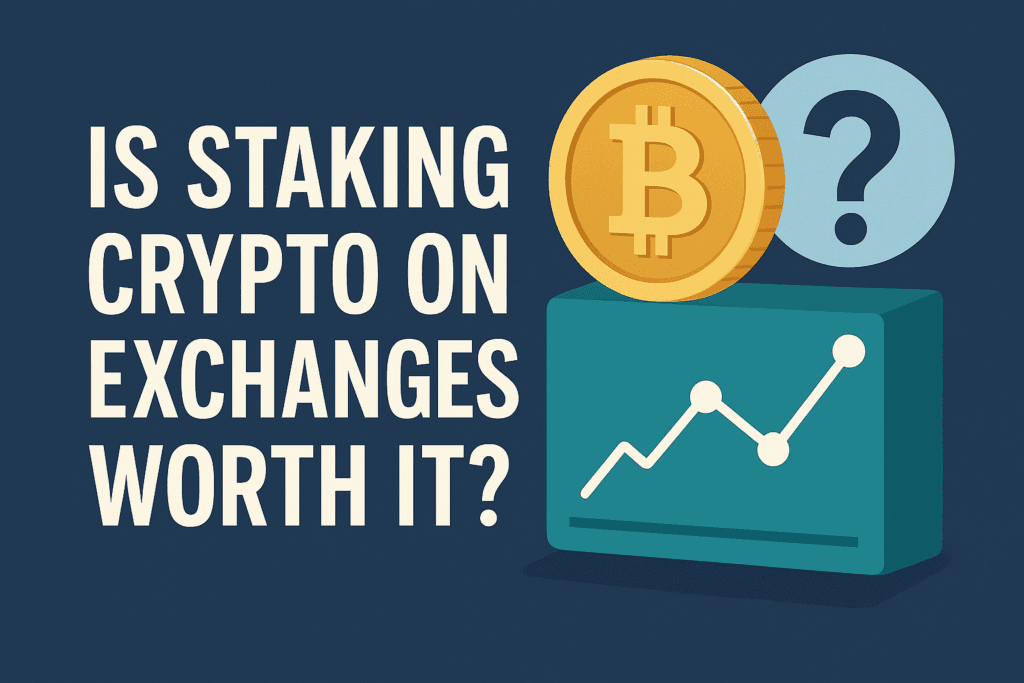Is Staking Crypto on Exchanges Worth It in 2025? Pros, Risks & Top Platforms Compared
By expert

As crypto adoption continues to rise in 2025, staking has emerged as one of the most popular ways to earn passive income from your digital assets. Among the available staking options, centralized crypto exchanges remain a go-to choice for beginners and casual investors. But with evolving regulations, APY shifts, and rising security concerns, many are asking the important question: is staking crypto on exchanges worth it?
In this blog post, we’ll explore the pros and cons of exchange-based staking, compare top platforms, and help you decide whether it’s the right strategy for you this year.
What is Crypto Staking on Exchanges?
Crypto staking involves locking up your tokens to help validate blockchain transactions. In return, you earn rewards—typically in the same token. Centralized exchanges like Kraken, Binance, and Coinbase offer staking services directly on their platforms, removing the need to run a validator or manage a separate wallet.
These platforms handle all technical aspects and distribute rewards automatically, making them ideal for crypto holders seeking a passive income stream without much hassle.
📌 Learn more in our detailed Crypto Staking Guide.
Pros of Staking on Exchanges in 2025
1. Ease of Use
Exchange-based staking is designed for simplicity. You don’t need to worry about setting up wallets, understanding slashing risks, or navigating validator software.
2. Low Minimum Requirements
Most exchanges allow staking with small amounts—as low as $10 worth of crypto.
3. Auto-Compounding
Some platforms like Binance offer auto-compounding features, where your staking rewards are reinvested to maximize your yield.
4. Liquidity Options
Certain exchanges now offer liquid staking alternatives, allowing you to trade your staked assets even while earning rewards.
5. Security Measures
Top-tier exchanges invest heavily in custodial security and insurance protocols to protect user funds.
Risks of Staking on Exchanges
While staking on exchanges is convenient, it isn’t without its drawbacks. Here are the key risks to be aware of in 2025:
1. Custodial Risk
When you stake on a centralized platform, you’re entrusting them with your private keys. If the exchange is hacked or goes insolvent, your staked funds could be at risk.
2. Regulatory Uncertainty
Governments are increasingly regulating crypto services, and exchange-based staking has come under scrutiny. It’s possible some services may be limited or shut down depending on local laws.
3. Lower Yields
Exchanges often take a percentage cut of staking rewards as fees. As a result, APYs are typically lower than those available through direct or DeFi staking.
4. Lock-up Periods
Some platforms require fixed lock-up durations, restricting your ability to access funds quickly if market conditions change.
Is Staking Crypto on Exchanges Worth It?
So, is staking crypto on exchanges worth it in 2025? The answer depends on your goals, risk tolerance, and level of experience.
If you’re a beginner looking for a simple, relatively low-risk way to earn passive income, staking on reputable exchanges remains a good option. You get predictable returns and hands-free management.
However, if you’re more experienced and want greater control, higher APYs, and the ability to self-custody your assets, consider staking via wallets or decentralized platforms.
Top Platforms for Exchange Staking in 2025
Here’s a comparison of some of the best crypto exchanges offering staking services this year:
| Exchange | Supported Coins | Average APY | Notable Features |
|---|---|---|---|
| Kraken | ETH, DOT, ADA | 3%–14% | High reliability, regulated, transparent fees |
| Binance | BNB, SOL, AVAX | 4%–20% | Auto-compounding, flexible lock-up terms |
| Coinbase | ETH, ATOM | 3%–6% | Beginner-friendly, fully regulated in the U.S. |
For real-time staking rates, visit our Live Crypto Staking Rates tracker.
Estimating Your Earnings
Wondering how much you could earn staking crypto on an exchange? Try our free Staking Calculator to estimate your returns based on current APY, lock-up duration, and amount invested.
FAQs: Is Staking Crypto on Exchanges Worth It?
1. Is staking crypto on exchanges safe?
It can be safe if you use regulated and secure platforms like Kraken or Coinbase. However, you’re still exposed to custodial risks and platform-specific vulnerabilities.
2. Can I stake stablecoins on exchanges?
Yes, some platforms offer staking or interest-earning options for stablecoins like USDT or USDC.
3. What happens if an exchange shuts down?
If the platform goes insolvent or is hacked, you may lose access to your staked funds. Always consider using exchanges with strong reputations and security histories.
4. Is it better to stake on a wallet?
Wallet staking (or DeFi staking) gives you full control and often higher APYs but comes with more complexity and personal responsibility.
5. Are staking rewards taxable?
Yes. In most jurisdictions, staking rewards are considered income and are subject to taxation. Keep accurate records for reporting.
Final Thoughts
Staking crypto on exchanges remains a worthwhile strategy in 2025 for those seeking a hands-off approach to earning yield. It offers ease of use, safety (with reputable platforms), and steady income, albeit with slightly lower returns compared to DeFi alternatives.
To maximize your returns, stay informed about APY trends and always compare platforms using our Live APY Staking Rates Tracker. If you’re just getting started, check out our Crypto Staking Guide to learn more.
Ultimately, the decision comes down to your comfort with custodial risk and your long-term investment goals.
What’s your biggest concern when it comes to staking crypto on exchanges—security, returns, or something else? Let us know in the comments!
